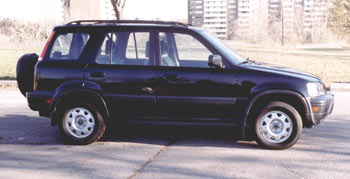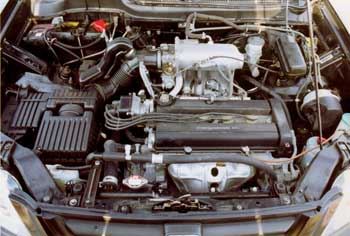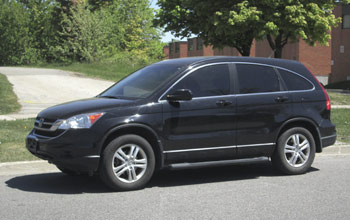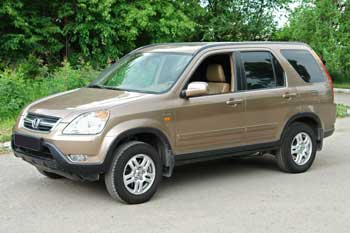1997-2001 Honda CR-V: engine, fuel economy, maintenance tips
Updated: October 10, 2019
Honda CR-V (Comfortable Runabout Vehicle) is a compact lightweight car-based SUV with a four-wheel independent suspension. The combination of reasonable fuel economy, practical interior and cargo space made the CR-V one of the most popular compact SUVs. The 1997-2001 CR-V was available as a front-wheel drive or four-wheel drive, although front-wheel drive models are rare.
The CR-V has a rear swing gate that opens to the passenger side. The swing gate also holds the spare tire.Available with a 5-speed manual or 4-speed automatic, the CR-V was offered with only one engine: the 126-hp 2.0L 4-cylinder DOHC. For 1999, the engine was modified to add 20 more horsepower. This is a good reliable engine, but it needs regular maintenance to last; read more below.
The CR-V has a roomy practical well-designed interior with simple instruments and easy to use controls. There are plenty of storage areas including a storage box under the front passenger's seat. The split rear seat folds almost flat for extra cargo space. A fold-out picnic table also works as a lid for the storage under the cargo area carpet.
The CR-V's all-wheel drive system is not designed for real off-roading, but it can help on slippery roads. In normal conditions, Honda CR-V is powered by the front wheels. If the front wheels start slipping, the hydraulic clutch engages the rear wheels.
In the government crash tests, the 1998-2001 Honda CR-V received 4 stars for the driver and 5 stars for the front passenger.
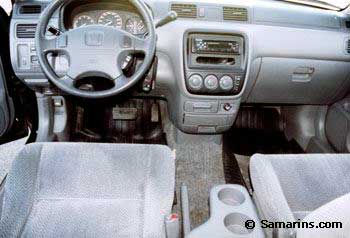 1997 Honda CR-V interior
1997 Honda CR-V interiorPros: Good fuel economy for an SUV, car-like handling, all-wheel drive, practical interior, cargo space, crash-test ratings, resale value.
Cons: Road and engine noise, underpowered, limited towing capacity, unstable in crosswinds.
Overall: If you need a cheap 4WD vehicle that is good on gas, this generation CR-V is still worth checking out, although at this age it might be difficult to find one in good shape. Still, not long ago, we came across a couple of used CR-Vs of this generation with over 180,000 miles that were still in a reasonable-good shape. The CR-V is fun to drive and is fairly easy to maintain. Overall, Honda CR-V is reliable, but it needs to be maintained well to avoid problems.
Advertisement
What to look for when buying a used Honda CR-V: Watch out for a trailer hitch. If the CR-V was used for towing a trailer, the transmission could be excessively worn. A strong jolt or clunk when shifting the automatic transmission into Reverse could indicate a transmission problem; avoid the car. The engine should run smoothly whether it's cold or hot. If it runs rough and misfires when cold, there might be a problem. Read more: How to inspect a used car - illustrated guide. Before buying, have the vehicle inspected by a mechanic; ask to check if the timing belt has been replaced.
You might also be interested:
Signs of engine problems when test-driving a used car
What mileage is OK for a used car?
Maintenance: Rust-proofing can help slow down corrosion if you live in the Rust Belt. Have engine oil changed regularly to keep your engine in good shape.
A bad ignition switch can cause the CR-V to stall intermittently; if you have this problem, have the ignition switch (electric part) checked out.
The 1997-2001 Honda CR-V engine has a timing belt that needs to be replaced every 105,000 miles or 168,000 kilometers according to the 2001 Honda CR-V owner's manual. A timing belt replacement could cost from $350 to $500 in a repair shop ($650-870 with the water pump).
The CR-V's engine needs periodic valve adjustment. If not adjusted in time, the valves can get too tight causing misfire. If the vehicle continues to be driven with the valves being too tight, you can end up with burnt valves. The repair is quite expensive. For this reason, If you haven't done valve adjustment in a long time, next time you take your CR-V for a tune-up, have the valve clearance checked/adjusted. The 2001 CR-V owner's manual recommends doing it every 105,000 miles or 168,000 kilometers.
A groaning, humming, chattering or squeaking noise from the rear end in turns could be cause by deteriorated rear differential oil. Changing rear differential oil with original Honda Dual Pump Fluid may help. Sometimes you need to drive the car in turns for a while after the fluid was changed to make the noise disappear, as it takes some time to get the clutch discs lubricated. Keep engine coolant topped up, as lack of coolant can cause overheating. Change transmission fluid as often as recommended in the owner's manual.
